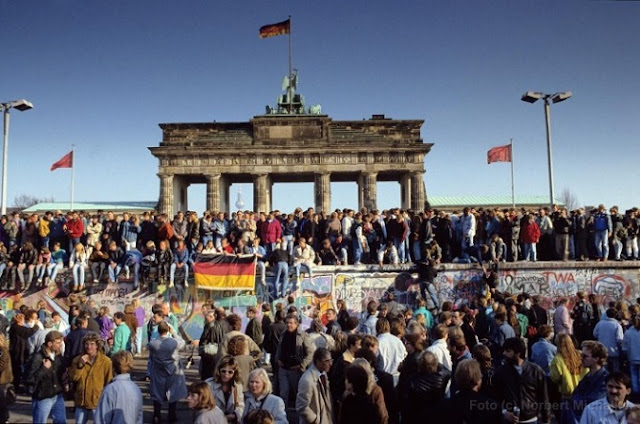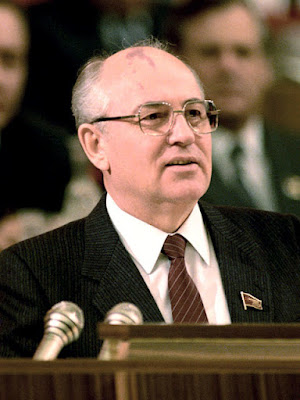On This Date In History
On October 3, 1990, less than one year after the destruction of the Berlin Wall, East and West Germany come together on what is known as “Unity Day.”
Since 1945, when Soviet forces occupied eastern Germany, and the United States and other Allied forces occupied the western half of the nation at the close of World War II, divided Germany had come to serve as one of the most enduring symbols of the Cold War.
Some of the most dramatic episodes of the Cold War took place there. The Berlin Blockade (June 1948–May 1949), during which the Soviet Union blocked all ground travel into West Berlin, and the construction of the Berlin Wall in 1961 were perhaps the most famous. With the gradual waning of Soviet power in the late 1980s, the Communist Party in East Germany began to lose its grip on power. Tens of thousands of East Germans began to flee the nation, and by late 1989 the Berlin Wall started to come down.
Shortly thereafter, talks between East and West German officials, joined by officials from the United States, Great Britain, France and the USSR, began to explore the possibility of reunification. Two months following reunification, all-German elections took place and Helmut Kohl became the first chancellor of the reunified Germany. Although this action came more than a year before the dissolution of the Soviet Union, for many observers the reunification of Germany effectively marked the end of the Cold War.
Mikhail Gorbachev
On October 3, 1863, expressing gratitude for a pivotal Union Army victory at Gettysburg, President Abraham Lincoln announces that the nation will celebrate an official Thanksgiving holiday on November 26, 1863.
The speech, which was actually written by Secretary of State William Seward, declared that the fourth Thursday of every November thereafter would be considered an official U.S. holiday of Thanksgiving. This announcement harkened back to when George Washington was in his first term as the first president in 1789 and the young American nation had only a few years earlier emerged from the American Revolution. At that time, George Washington called for an official celebratory “day of public thanksgiving and prayer.” While Congress overwhelmingly agreed to Washington’s suggestion, the holiday did not yet become an annual event.
Thomas Jefferson, the third president, felt that public demonstrations of piety to a higher power, like that celebrated at Thanksgiving, were inappropriate in a nation based in part on the separation of church and state. Subsequent presidents agreed with him. In fact, no official Thanksgiving proclamation was issued by any president between 1815 and the day Lincoln took the opportunity to thank the Union Army and God for a shift in the country’s fortunes on this day in 1863.
The fourth Thursday of November remained the annual day of Thanksgiving from 1863 until 1939. Then, at the tail-end of the Depression, President Franklin D. Roosevelt, hoping to boost the economy by providing shoppers and merchants a few extra days to conduct business between the Thanksgiving and Christmas holidays, moved Thanksgiving to November’s third Thursday. In 1941, however, Roosevelt bowed to Congress’ insistence that the fourth Thursday of November be re-set permanently, without alteration, as the official Thanksgiving holiday.
On October 3, 1917, six months after the United States declared war on Germany and began its participation in the First World War, the U.S. Congress passes the War Revenue Act, increasing income taxes to unprecedented levels in order to raise more money for the war effort.
The 16th Amendment, which gave Congress the power to levy an income tax, became part of the Constitution in 1913; in October of that year, a new income tax law introduced a graduated tax system, with rates starting at 1 percent and rising to 7 percent for taxpayers with income above $500,000. Though less than 1 percent of the population paid income tax at the time, the amendment marked an important shift, as before most citizens had carried on their economic affairs without government knowledge. In an attempt to assuage fears of excessive government intervention into private financial affairs, Congress added a clause in 1916 requiring that all information from tax returns be kept confidential.
By then, however, preparation for and entry into World War I had greatly increased the government’s need for revenue. Congress responded to this need by passing an initial Revenue Act in 1916, raising the lowest tax rate from 1 percent to 2 percent; those with incomes above $1.5 million were taxed at 15 percent. The act also imposed new taxes on estates and excess business profits.
By 1917, largely due to the new income tax rate, the annual federal budget was almost equal to the total budget for all the years between 1791 and 1916. Still more was required, however, and in October 1917 Congress passed the War Revenue Act, lowering the number of exemptions and greatly increasing tax rates. Under the 1917 act, a taxpayer with an income of only $40,000 was subject to a 16 percent tax rate, while one who earned $1.5 million faced a rate of 67 percent. While only five percent of the U.S. population was required to pay taxes, U.S. tax revenue increased from $809 million in 1917 to a whopping $3.6 billion the following year. By the time World War I ended in 1918, income tax revenue had funded a full one-third of the cost of the war effort.
On October 3, 1942, German rocket scientist Wernher von Braun’s brainchild, the V-2 missile, is fired successfully from Peenemunde, as island off Germany’s Baltic coast. It traveled 118 miles. It proved extraordinarily deadly in the war and was the precursor to the Intercontinental Ballistic Missiles (ICBMs) of the postwar era.
German scientists, led by von Braun, had been working on the development of these long-range missiles since the 1930s. Three trial launches had already failed; the fourth in the series, known as A-4, finally saw the V-2, a 12-ton rocket capable of carrying a one-ton warhead, successfully launched.
The V-2 was unique in several ways. First, it was virtually impossible to intercept. Upon launching, the missile rises six miles vertically; it then proceeds on an arced course, cutting off its own fuel according to the range desired. The missile then tips over and falls on its target, at a speed of almost 4,000 mph. It hits with such force that the missile burrows itself into the ground several feet before exploding. It had the potential of flying a distance of 200 miles, and the launch pads were portable, making them impossible to detect before firing.
The first launches as part of an offensive did not occur until September 6, 1944 when two missiles were fired at Paris. On September 8, two more were fired at England, which would be followed by more than 1,100 more during the next six months. More than 2,700 Brits died because of the rocket attacks.
After the war, both the United States and the Soviet Union captured samples of the rockets for reproduction, they also captured the scientists responsible for their creation.



















No comments:
Post a Comment